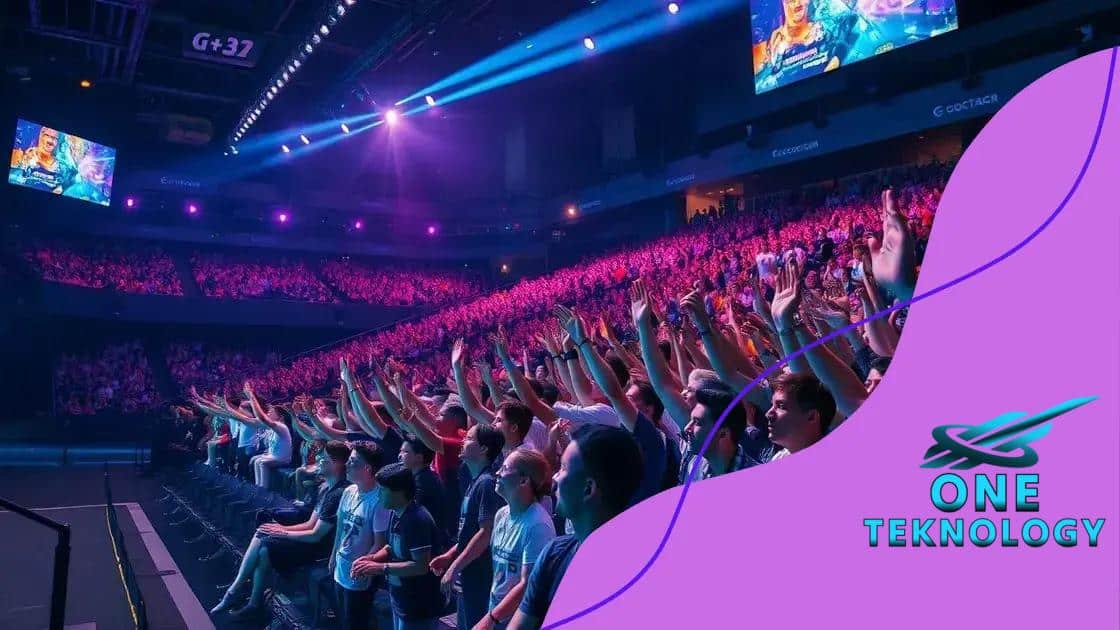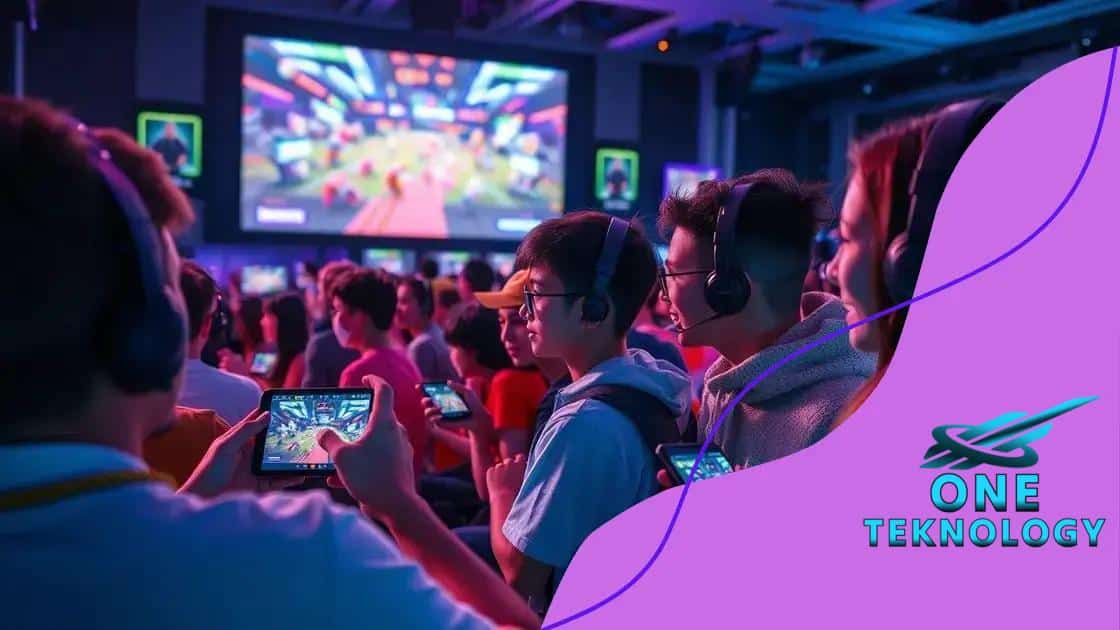How e-sports are influencing mainstream media content

How e-sports are influencing mainstream media content through technological advancements, brand collaborations, and engaging experiences is reshaping entertainment and attracting younger audiences.
How e-sports are influencing mainstream media content is shaping the entertainment landscape in unexpected ways. Have you noticed how the lines between gaming and media are blurring? In this article, we’ll dive into the fascinating world of e-sports and its growing impact.
The rise of e-sports in popular culture
The rise of e-sports in popular culture has transformed the way we view gaming. Once seen as a niche interest, e-sports now draw millions of fans globally, creating a vibrant and expanding community. Major tournaments fill arenas, and games are streamed to millions online, showcasing the immense popularity of competitive gaming.
Growth of E-sports Communities
E-sports communities have quickly gained traction. Players and fans connect online, sharing strategies and supporting their favorite teams. This connection has fostered a sense of belonging and identity among enthusiasts.
- Online platforms allow for real-time interaction.
- Social media plays a key role in promoting events.
- Fan engagement is through forums and streaming services.
Many universities are now offering scholarships for gamers, further legitimizing e-sports as a viable career path. This acceptance has encouraged more individuals to pursue competitive gaming, leading to an influx of talent in the field.
Influence on Traditional Sports
As e-sports gains recognition, it has begun to influence traditional sports as well. Major sporting leagues are now investing in e-sports teams and events. These collaborations help bridge the gap between physical and digital sports, creating opportunities for wider audiences.
- Increased viewership for joint events.
- New merchandise and branding strategies.
- Shared fan experiences at live events.
The impact of e-sports on popular culture is undeniable. It continues to shape entertainment and media in innovative ways, appealing to diverse audiences and redefining how we engage with competitive activities. As e-sports continue to evolve, we can only anticipate more fascinating developments on the horizon.
Impact of e-sports on traditional media formats
The impact of e-sports on traditional media formats is significant and continues to grow. As more viewers tune into e-sports events, traditional media companies are adapting their strategies to engage this new audience. This shift has resulted in unique programming and innovative collaborations.
Shifts in Broadcasting
Televisions and streaming services are changing how e-sports content is aired. Networks are increasingly dedicating time slots to e-sports tournaments. They recognize that the demographic of e-sports fans tends to be younger and digitally savvy.
- Live streaming platforms like Twitch are gaining popularity.
- Networks are producing original e-sports shows.
- Partnerships with gaming developers are forming.
Print media has also adapted by creating dedicated sections for gaming and e-sports news. Magazines are featuring player profiles and tournament coverage that were not commonplace before.
Advertising and Sponsorships
Advertising revenue is shifting as brands seek to connect with e-sports audiences. Sponsorship deals are increasingly prevalent, with brands directly partnering with teams and events. This provides brands with an opportunity to reach a dedicated fanbase.
- Brands are investing in team sponsorships.
- Products are integrated into gaming streams.
- Cross-promotion with traditional sports is emerging.
The fusion of e-sports and traditional media is creating new pathways for content creation. As these formats continue to evolve, they reshape how audiences consume media and interact with their favorite games. This evolving landscape encourages both sectors to be innovative and forward-thinking, ensuring that they meet the expectations of modern viewers.
How e-sports engage younger audiences

E-sports have a unique way of engaging younger audiences. This interactive form of entertainment captivates many young people who previously may not have been interested in traditional sports. The blend of gaming and competition creates an exciting environment for fans.
Interactive Features of E-sports
Many e-sports platforms offer interactive elements that draw in younger viewers. These features include live chats and viewer polls during matches. Fans enjoy feeling part of the action, which enhances their overall experience.
- Real-time engagement through live chats.
- Viewers can vote on game outcomes.
- Opportunities for fan discussions during events.
This sense of community encourages consistent viewership, as fans develop connections with each other and their favorite players. Additionally, younger audiences appreciate the accessibility of e-sports. With just an internet connection, they can watch tournaments from the comfort of their homes or on mobile devices.
Relatable Content and Influencers
Relatable content featuring young, charismatic players helps attract even more fans. When audiences see individuals like themselves succeeding, it fosters motivation and aspiration. Player streams on platforms like Twitch connect fans directly with their favorite gamers, making the experience personal and engaging.
- Gaming influencers create a personal brand.
- Young players can see their dreams reflected.
- Content is often humorous and relatable.
This connection is crucial as younger audiences tend to gravitate towards platforms that feel genuine and incorporate their interests. As e-sports continue to flourish, they are set to remain a significant force in engaging younger generations, paving the way for future gaming cultures.
Collaborations between e-sports and mainstream brands
Collaborations between e-sports and mainstream brands have become increasingly common as both industries recognize mutual benefits. These partnerships leverage the audience and popularity of e-sports while providing brands with fresh marketing avenues.
Brand Sponsorships
Many brands now sponsor e-sports teams and tournaments. This sponsorship allows companies to reach a young, engaged audience. Players often wear branded gear, giving companies valuable exposure during competitions.
- Team jerseys often feature brand logos.
- Sponsorships can cover events and streaming platforms.
- Co-branded content highlights both the team and sponsor.
These sponsors not only provide financial support to teams but also create unique marketing opportunities through content creation and interactive experiences for fans. For instance, brands may launch special product lines inspired by popular games.
Co-Hosting Events
Brands increasingly engage in co-hosting events alongside e-sports organizations. Such collaborations create a unique atmosphere where fans can connect with both the games and the brands promoting them. This brings more excitement and helps brands stand out.
- Live performances at gaming events attract fans.
- Interactive booths allow fans to experience products.
- Brand representatives offer giveaways and promotions.
With the overlapping audiences of gaming and mainstream brands, these collaborations are set to grow. Brands that adapt their marketing strategies to incorporate e-sports not only tap into new customer bases but also build a community around their products that resonates with younger demographics.
Future trends of e-sports in media
The future trends of e-sports in media are exciting and continually evolving. As technology advances, we see new opportunities for growth in how e-sports are presented and consumed. The integration of virtual reality (VR) and augmented reality (AR) into e-sports is on the rise, offering immersive experiences that draw in even more fans.
Enhanced Viewer Experiences
E-sports platforms are beginning to incorporate VR to enhance the viewer experience. Virtual reality allows fans to feel like they are part of the action. They can explore 3D environments or watch matches from different perspectives, making viewing much more engaging.
- Fans can choose their viewing angles in real-time.
- Interactive elements create a connection between players and spectators.
- VR environments may include virtual arenas populated with avatars.
This evolution could significantly increase audience participation and satisfaction, leading to a growing community of e-sports enthusiasts.
Streaming Innovations
Streaming platforms continue to innovate, enhancing how e-sports content is delivered. Many platforms are partnering with major e-sports organizations to provide exclusive content. This includes behind-the-scenes footage and player interviews that give fans deeper insights into the games and players they love.
- Exclusive content fosters more community interaction.
- Subscription models offer fans unique benefits.
- Improved chat features enhance real-time fan engagement.
As the lines between traditional media and e-sports blur, we may see more collaborations involving prominent media entities. These partnerships allow for larger marketing campaigns to promote events, ensuring that e-sports remains in the mainstream spotlight.
Moreover, advertising trends will evolve as brands will find innovative ways to reach e-sports audiences. Influencer-led marketing campaigns are becoming essential in tapping into the younger demographic that dominates the e-sports scene. Overall, the future of e-sports in media looks promising as it becomes further integrated into our daily entertainment choices.
FAQ – Frequently Asked Questions about E-sports and Media
What are some future trends in e-sports?
Future trends include the integration of VR and AR for immersive experiences, enhanced streaming content, and increased collaborations with mainstream brands.
How are brands partnering with e-sports?
Brands are sponsoring teams, co-hosting events, and creating exclusive content to engage younger audiences and leverage the popularity of e-sports.
Why are e-sports popular among younger audiences?
E-sports engage younger audiences due to interactive features, relatable content from influencers, and a strong sense of community among fans.
How are streaming services changing e-sports?
Streaming services are innovating by providing exclusive behind-the-scenes content, improving fan engagement through interactive features, and enhancing the overall viewing experience.






